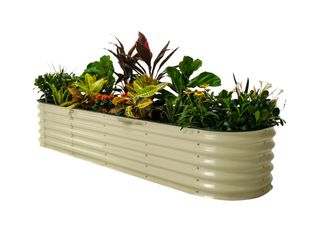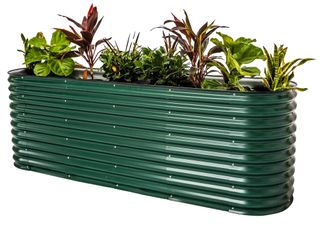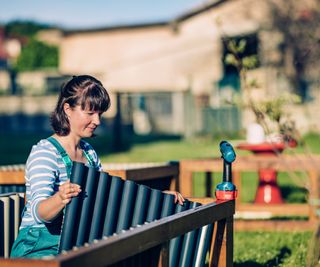Raised garden beds are incredibly popular for a variety of reasons. Often the only question is what type of material to use for your raised beds. There are numerous options available from treated wood metal to plastic to cinder block, and the list goes on. Each option has its share of up and downsides.
One obvious material choice is metal, and it’s gaining a lot of popularity, particularly with our staff here. What are the pros and cons of metal raised beds? For instance, are galvanized raised beds a better option than other types of metal? How about using old metal that may leach into the soil?
Here’s everything I’ve unearthed about the various types of metal planter boxes or beds and their pros and cons.
Benefits of Raised Garden Beds
As I age, yes, it’s happening, I realize how important accessibility is becoming… especially in my garden. Raised garden beds help me access my plots with less difficulty, making everything from planting to watering to harvesting easier on my body.
Accessibility isn’t the only benefit of raised beds, however. Raised beds also warm faster than in-ground garden beds, meaning you can plant and harvest earlier. You can easily control the type of soil without digging up half the yard, which means you get the correct pH and nutrients for your crops right there at your fingertips.
(Image credit: egon69 / Getty Images)
Different Types of Metal Garden Beds
As mentioned, raised garden beds can be made out of all sorts of materials, each with their own pros and cons. Metal happens to be a long-lasting material that has definitive aesthetic appeal in the garden.
I live in the city, but literally a 5-minute drive out the landscape is rural – dotted with farmhouses, barns, cattle, and fields of hay and other crops. I mention this because long before they became popular, I was familiar with one of the classic metal raised beds – the cattle trough or stock tank.
Out in these rural areas, the cattle trough is used to feed and water livestock, but made its way into urban areas as a sleek raised garden bed option. Today I see them everywhere filled with flowers or used as mini veggie garden plots.
If getting your hands on an authentic cattle trough proves too tough, or if you don’t fancy converting it into a raised bed, consider buying a modular kit from Vego.

17″ Tall 9 In 1 Modular Metal Raised Garden Bed Kit – $169.95
This modular raised bed kit can be assembled to the size and shape that perfectly fits your garden space.
Metal Raised Garden Bed Ideas
There are multiple reasons for choosing a metal garden bed. They last for a long time. Research indicates that they can last for 20 years – many times longer than their wooden counterparts. They’re easy to maneuver into an area and set up is a breeze. They are less likely to foster pests and are low maintenance.
They are incredibly tidy and aesthetically pleasing and available in an array of shapes from oblongs to squares. Many have legs or tall sides to give them extra height, or come in a fun array of colors beyond shiny steel.

32″ Extra Tall 10 In 1 Modular Metal Raised Garden Bed Kit – $299.95 – $309.95
Vego Raised Garden Beds come in beautiful colors and several convenient heights and sizes.
Frequently Asked Questions
What do you put on the bottom of a metal raised garden bed?
There are all kinds of things you can put at the bottom of a metal raised garden bed. If you have a self-contained unit like a cattle trough, lining the ground with layers of cardboard will likely be enough to slow weeds.
However other structures may need burlap sacking, landscape fabric, stainless steel mesh or wide mesh hardware cloth. These heavier-duty materials are excellent to keep critters like gophers and moles from digging in your bed.
This article features products available from third-party vendors on the Gardening Know How Shop.


